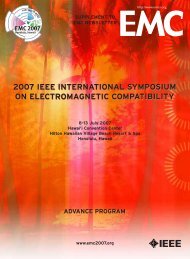reciprocity and emc measurements - IEEE Electromagnetic ...
reciprocity and emc measurements - IEEE Electromagnetic ...
reciprocity and emc measurements - IEEE Electromagnetic ...
You also want an ePaper? Increase the reach of your titles
YUMPU automatically turns print PDFs into web optimized ePapers that Google loves.
11SummaryIn this paper we have discussed the <strong>reciprocity</strong> theoreminterrelating two states of one <strong>and</strong> the same Kirchhoffnetwork (linear passive network) as determined by theterminations of that network. We have givenapplications improving the underst<strong>and</strong>ing of transferimpedance, filter <strong>and</strong> site attenuation <strong>measurements</strong>. Inaddition, we have used the theorem to facilitate a DMvoltage to CM current conversion measurement.We discussed the <strong>reciprocity</strong> theorem interrelatingthe electromagnetic fields in two states that can occur inone <strong>and</strong> the same domain in space, <strong>and</strong> from thistheorem we derived the hybrid <strong>reciprocity</strong> theorem. Thelatter theorem was applied to a tuned λ/2 dipole, to themeasurement of antenna factors, to probe calibration ina TEM cell <strong>and</strong> the uncertainties associated with these<strong>measurements</strong>. We also used the hybrid <strong>reciprocity</strong>theorem to discuss aspects of radiated immunity<strong>measurements</strong>.Finally, we used the <strong>reciprocity</strong> the <strong>reciprocity</strong>theorems in a discussion about the <strong>reciprocity</strong> of theshielding effectiveness <strong>and</strong> in a simple method toestimate the interference potential of a field (at in-b<strong>and</strong>frequencies) incident on an antenna.AcknowledgementsThe author wishes to acknowledge the valuable <strong>and</strong>interesting discussions with Dr. Stef Worm of PhilipsEMC Competence Centre in Eindhoven. He also wishesto thank the library staff at Philips Research in Eindhoven.The presence of all historical publications in thelibrary’s collection made his nostalgic journey a pleasant‘one-stop’ event.References[1] S. Ballantine, “The Lorentz Reciprocity Theoremfor Electric Waves”, Proc. IRE, vol.16, pp 513−518, 1928.[2] H. von Helmholtz, H<strong>and</strong>buch der PhysiologischenOptik (1866); Verlag von Leopold Voss, Hamburg/Leipzig,3e Auflage, pp 200−203, 1909.[3] J.W. Strutt, Baron Rayleigh, The theory of sound,vol. 1, pp. 150−157, 1877; reprinted by Mac-Millan, London, 1926.[4] H.A. Lorentz, “Het theorema van Poynting over deenergie van het electromagnetisch veld en een paaralgemene stellingen over de voortplanting van hetlicht”, Verslagen Kon. Akademie van Wetenschappen,B<strong>and</strong> 4, p.176, Amsterdam, 1896.[5] H.A. Lorentz, “The theorem of Poynting concerningthe energy in the electromagnetic field <strong>and</strong>two general propositions concerning thepropagation of light”, Collected papers, Nijhoff,Den Haag, vol. III, p 1, 1936.[6] J.R. Carson, “A generalization of the reciprocaltheorem”, Bell Syst. Techn. Jrnl., vol. 3, pp 393−399, July 1924.[7] A. Sommerfeld, “Das Reziprozitäts-Theorem derdrahtlosen Telegraphie”, Zeitschrift für Hochfrequenztechnik,B<strong>and</strong> 26, Heft 4, pp 93−98, 1925.[8] M. Abraham, Theorie der Elektrizität, TeubnerVerlag, Berlin, 1921.[9] The Stuart Ballantine Medal, to be awarded inrecognition of outst<strong>and</strong>ing achievement in thefields of Communication <strong>and</strong> Reconnassancewhich employ electromagnetic radiation, TheFranklin Institute, Philadelphia, U.S.A.[10] S. Ballantine, “Reciprocity in electromagnetic,mechanical, acoustical, <strong>and</strong> interconnectedsystems”, Proc. IRE, vol. 17, pp 929-951, June1929.[11] R.M. Wilmotte, “The nature of the field in theneighbourhood of an antenna”, Journ. IEE, vol. 66,pp. 961−967, 1928.[12] C.T. Tai, “Complementary Reciprocity Theoremsfor Two-Port Networks <strong>and</strong> Transmission Lines”,<strong>IEEE</strong> Trans. on Education, vol. 37, no.1, pp42−45, 1992.[13] C.T. Tai, “Complementary Reciprocity Theoremsin <strong>Electromagnetic</strong> Theory”, <strong>IEEE</strong> Trans. onAntennas <strong>and</strong> Propagation, vol.40, no.6, pp675−681, 1992.[14] A.T. de Hoop, H<strong>and</strong>book of radiation <strong>and</strong>scattering of waves, Academic Press Ltd., London,1995.[15] D. Quak, “<strong>Electromagnetic</strong> Susceptibility Analysisof Open-Wire Systems”, Proc. <strong>IEEE</strong> Intern. Symp.on EMC, Atlanta, pp 423−428, August 1995.[16] K.F. S<strong>and</strong>er <strong>and</strong> G.A.L. Reed, Transmission <strong>and</strong>propagation of electromagnetic waves, CambridgeUniversity Press, Cambridge, 1986.[17] J.J. Goedbloed, “Reciprociteit en EMC-metingen”,EMC/ESD Praktijk, 1) pp.5−7, Sept. 2001, 2) pp5−7, Okt. 2001, 3) Elektronica, EMC/ESD Praktijk,pp. 5−7, Nov. 2001, “Over het afschermen vanvelden (4)”, Elektronica, EMC/ESD Praktijk, pp.44−45, Mei 2002.[18] B.D.H. Tellegen, “A general network theorem,with applications”, Philips Research Reports, 7,pp259−269, 1952.[19] J.J. Goedbloed, <strong>Electromagnetic</strong> Compatibility,Kluwer Technische Boeken, Deventer, 1997 (originallypublished by Prentice Hall, 1992).[20] I.P. Macfarlane, “A Probe for the Measurement ofElectrical Unbalance of Networks <strong>and</strong> Devices”,<strong>IEEE</strong> Trans. on EMC, vol. 41, pp. 3−14, Feb.1999.[21] J.J. Goedbloed, “Aspects of EMC at the equipmentlevel”, Proc. Intern. Symp. on EMC, Zurich, Suppl.pp 23−38, 1997 <strong>and</strong> <strong>IEEE</strong> Intern. EMC Symposium,Austin, U.S.A., 1997.[22] A. Sugiura, “Formulation of Normalized SiteAttenuation in Terms of Antenna Impedances”,Trans. <strong>IEEE</strong> on EMC, vol. 32, pp. 257−263, Nov.1990.[23] G.H. Brown <strong>and</strong> R. King, “High frequency modelsin Antenna investigations”, Proc. IEE, vol. 22, pp.457−480, April 1934.[24] J.R. Carson, “Reciprocal theorems in radio communication”,Proc.IRE, vol.17, pp 952-956, June1929.[25] D. Quak <strong>and</strong> A.T. de Hoop, “Shielding of WireSegments <strong>and</strong> Loops in Electric Circuits by
















